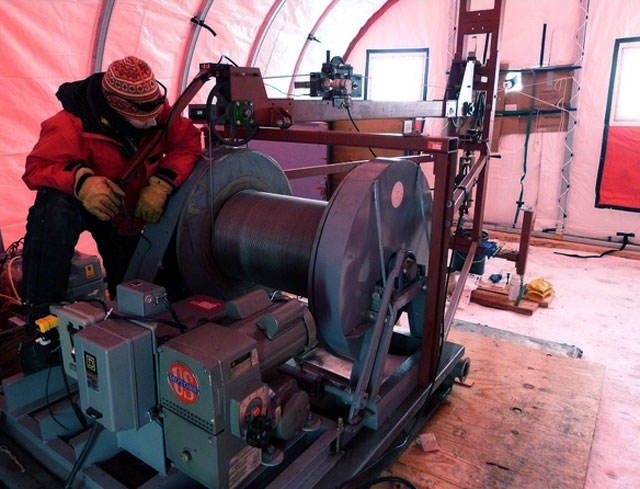|
Page 2/2 - Posted June 29, 2012
Replicate cores should help shed light on abrupt climate changesAn abrupt climate change is an event that occurs on a timescale measured in decades. An interstadial is a warm interlude during a glacial period that begins with an abrupt warming of about 10 degrees Celsius in Greenland and Europe that last several hundred years. There were more than 20 interstadials during the last glacial period, which lasted about 100,000 years. It ended about 10,000 years ago with the beginning of the current Holocene, a warm pause between glacial periods known as an interglacial. The changes in Earth's orbit — known as the Milankovitch Cycle Severinghaus said a sudden change in water mass circulation in the Atlantic Ocean appeared to trigger Interstadial 8. At least that’s the hypothesis. “We’re testing it rigorously by looking at which changes first — Antarctica or Greenland,” he explained. “The reason this hasn’t been possible before is because all Antarctic ice cores, except WAIS Divide, are rather low-accumulation-rate ice cores.” Most ice cores have annual layers about 2 to 3 centimeters thick, with even that resolution disappearing toward the bottom of the ice sheet, as the layers compress together. The WAIS Divide ice core has layers as thick as 22 centimeters per year. “These events are resolved in exquisite detail. We’ll be able to say whether some event happened in Antarctica 10 years before or 10 years after the corresponding event in Greenland,” he said. The complex relationship between the polar regions was the subject of a paper recently published in the journal Geophysical Research Letters on which Severinghaus was a co-author. The researchers found evidence of Europe’s Little Ice Age in the WAIS Divide borehole, suggesting it was a global event. [See related article — Global phenomenon: WAIS ice core reveals connection to Little Ice Age in Northern Hemisphere.]Another interstadial the researchers will target with the replicate drill is known as the Bølling oscillation, which occurred about 15,000 years ago and is found about 2,700 meters deep in the ice core record. The WAIS Divide team also hopes to bring up ice containing ash from a major volcanic event known as Old Faithful that took place about 18,000 years ago when the ice sheets reached their maximum extent for the last time. Did the volcanic event have a role in ending the last ice age? That’s another question the project hopes to address with the additional ice, according to Severinghaus. That will hinge on Shturmakov and his team doing what no one has done before. One of the biggest challenges is the requirement that the drill must deviate a few degrees toward the upside of the borehole. “It’s much harder to do the deviation,” Shturmakov said. “It’s hard because you need push the drill on the upper side. … It’s a major challenge for the replicate drilling.” The “uphill” requirement is because the researchers are still interested in measuring properties of the borehole itself. Borehole logging involves lowering an instrument that measures properties such as the geometry of the borehole and the temperature of the surrounding ice. The changes in the shape of the borehole since the ice core was drilled give information on the flow of the ice, and the temperatures reveal the past temperatures at the site. Severinghaus said ideally that replicate coring would wait until the borehole measurements were complete. But the WAIS Divide field camp, particularly the arch housing the drilling operation, is being crushed by the high snow accumulation. “It’s a time-constraint situation. We don’t have infinite time to do this, unfortunately,” Severinghaus said. “I have a lot of confidence that they’re going to figure it out and we’re going to get [replicate] core this time around.” NSF-funded research in this story: Jeffrey Severinghaus, University of California San Diego-Scripps Institution of Oceanography, Award No. 1043421 |



For USAP Participants |
For The Public |
For Researchers and EducatorsContact UsNational Science FoundationOffice of Polar Programs Geosciences Directorate 2415 Eisenhower Avenue, Suite W7100 Alexandria, VA 22314 Sign up for the NSF Office of Polar Programs newsletter and events. Feedback Form |




